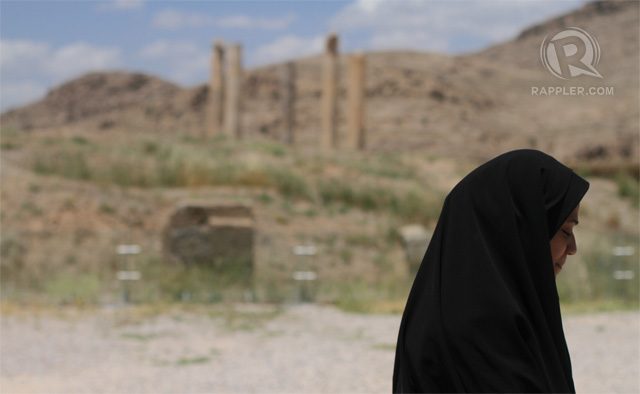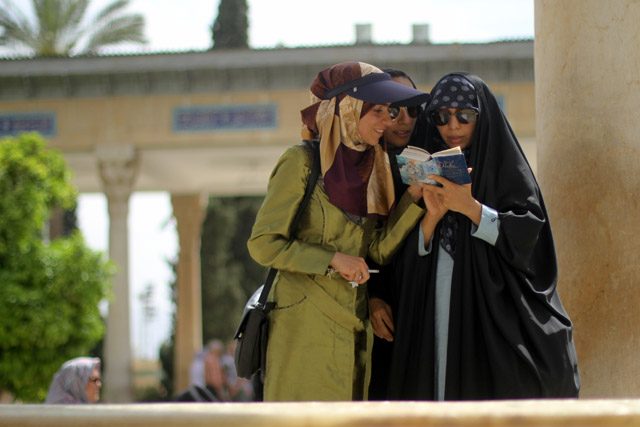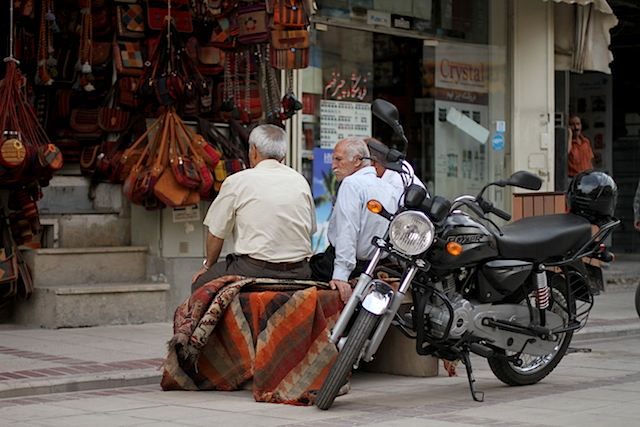SUMMARY
This is AI generated summarization, which may have errors. For context, always refer to the full article.

SHIRAZ, Iran – “Our children,” the woman with the fading blond hair tells us, “thought we had lost our minds.”
The woman is in her mid-60s, white linen blouse crumpled, scarf tied tight under her chin, one hand hanging on to a plastic grip as the bus makes its way from tarmac to terminal.
The bus is crowded. Half the people are standing, most of them graying couples clutching handles of wheeled suitcases. The woman in linen is Australian, and so is her husband. Both had decided to join a tour group to Iran, in the teeth of their children’s terrified opposition.
Inside the terminal, I fill out my forms and wait. The visa office is tiny, crowded with mismatched chairs. A portly man with a handlebar mustache sits behind a battered wooden desk with a chipped glass top, slowly checking passports. Then the visa is stamped, the fee is paid, and I’m off, scarf wrapped clumsily around my head, into the crisp air of a cold May dawn, past roads festooned with strings of neon bulbs and lined with faded stone apartments.
***
This is Shiraz, Iran, in the spring of 2014. Shiraz, of the wide white roads and citrus trees and two-apple shisha, where public hangings are third highest in the country and where it is easier, sometimes, to have 20 liters of homemade wine delivered to your front door than a 6-pack of beer.
Many thousands of years ago, or so the legend goes, the kingdom of Persia was ruled by a mythical king named Jamshid. He was king and priest, master of all men, protector of the sky, who ruled from a jeweled throne that flew through the heavens on the shoulders of fairies and demons. For hundreds of years he reigned over his many realms in a golden age of justice and peace. There was gold and medicine and perfumes from roses and ambergris, magnificent ships sailing across the water, palaces that glowed in the sun built of granite and ruby, all the work of the greatest of all great leaders whose head was ringed by a halo of divine light.
For the longest time, the city of Persepolis was known as Takht-i Jamshēd, the Throne of Jamshid. The road to Persepolis, 45 minutes from Shiraz, goes past a handful of red gas stations and field after field of wheat. Persepolis, of the soaring pillars and broken stone, was built by Darius the First and his son Xerxes for the glory of the Persian Empire.
In the time of Xerxes, before the city was torched by the armies of Alexander the Great, the high lords of the Persian Empire from Babylon to India strode with their tributes through the Gate of All Nations, past stone pillars flanked by lamassus – enormous bulls with the heads of men and the wings of eagles.
It is an obvious irony, that this once-glittering bastion of civilization is now locked in isolation. The lamassus still stand guard today, thousands of years later, battered stone faces now watching over schoolchildren and camera-wielding seniors. Tour guides bemoan the small fraction of tourists who place Iran on their itineraries, scarcely the numbers that flood Beirut or Istanbul.
It could be the financial sanctions, they say, that have deprived Iran of trade and withheld medicine and cars and replacement parts for their ageing aircrafts. Or it could be that the romance of Persia’s glorious palaces and perfumed gardens has dissolved into the western reimagining of Iran – a country populated by Kalashnikov-wielding terrorists and cowed, black-veiled women.
***
I meet a woman named Azam, in her early 30s, a beautiful woman whose dark eyes and quick smile has waiters in coffee houses and traders in the bazaar quietly asking for her phone number.

Azam’s sisters are all married, all to neighborhood boys. Azam hopes to do better for herself. Now she worries about the man she has called her special friend for 3 years. He makes eyes at every woman, she says. She has armed herself with a handful of imported books from the West, all with contradictory instructions on how a woman can keep a man, rules that Azam attempts to apply.
It is Azam who wraps my scarf securely around my head, who tells me the length of my skirt can still be dangerous, who teaches me the proper way to line my eyes while standing at the center of a public park. Leaving my apartment means wrapping my hair in a shawl, means covering arms and legs and neck, means making sure my mantle reaches my knees and no skin shows to the ankle, means wearing all of it, layers of it, in the scorching white heat of May.
Religion doesn’t matter, neither does nationality or race or upbringing. The dress code applies to all women.
The young men of Shiraz and Tehran dress much as they do in Manila or Bangkok, in bright-colored jeans and thin cotton shirts. It is difficult to avoid resentment. The romance of the headscarf slips away quickly, especially after men in bazaars mutter angrily in Farsi at careless foreigners whose veils slide down their backs. I fold up my skirt an inch, and light a cigarette.
***
There was a young man named Kemal, who saw a girl walking on the road to school. Young men like Kemal had trouble meeting women. The women he saw were veiled and cloistered. There were no cheerleaders in short skirts at basketball games, no clubs or bars or graduation balls or parties where a conversation could be struck, where eyelashes could be lowered and fluttered.
He told her she was beautiful. He told her about himself. He told her he would like to be her friend. For days she never said a word, but he followed anyway, content to watch as she walked to school.
Kemal fell in love that day. The young woman walked past him as he stared, and so he walked behind her. He followed her, every day, until finally she spoke. She told him to go away. Then she looked back, and smiled.
Her name was Haniye. They were married more than two years after they met. Fourteen years later, Kemal still calls her Honey. Every day, he tells her she is beautiful.
***
The rules for love and relationships are different here. Every man is a friend or a fiancé or a husband, very few will refer to a boyfriend. Kemal’s story may be typical of Iranian men a generation before. Today, there are women who meet boyfriends in chat rooms and sneak into Facebook through filters and VPNs, who write anonymous posts in blogs and pose in sunglasses without headscarves, who move quickly from WeChat to BeeTalk to Viber every time the government slams down a platform.
There are small rebellions everywhere. Inside homes and at private dinners and under the neon lights of the underground party scene, women strip off coats to show off tattooed breasts, skirts the size of handkerchiefs and tight black dresses slit to the thigh.
“I’ve never gotten used to the veil,” confesses a young woman in a yellow coat. “My mother never did, and it’s been more than 30 years.”
Feminism is not a concept here. It is a living, breathing, everyday struggle, and it is as dangerous as it is constant. Many admit it is only fear of punishment that keeps their veils wrapped around their heads. They are aware there are places where a woman can walk hand in hand with a man without being questioned, where a woman is not worth half of a man (100 camels is the blood price for a man in Iran, 50 for a woman), and where finding out a relative has been arrested is not cause for celebration – in Iran, an arrest, after all, is proof of life.
Outside, in public, on the street, the trench coats may be buttoned to the neck, but the waists are cinched tight. There are always the unlucky few who catch the eye of the morality police for questioning, whose rules are often so arbitrary that a coat considered acceptable one day can be reason for arrest the next. Dyed blond hair curls over eyes beneath loose veils. Black leggings cling to calves instead of loose trousers. Sleeves are pushed to above the elbow. Red-manicured feet are shod in silver sandals that glitter under dark skirts.
By the rules of the Islamic Republic of Iran, millions of women violate the dress code every day.
***

In a restaurant in Tehran, a waiter asks us what we want to drink. We order beer, and the waiter grins, and pretends to write it down. Then he looks up and asks again.
Here, anyone caught selling alcohol can earn a public lashing. Repeat offenders are sentenced with death. Shirazi wine, as the Shirazis know it, is made in basements and bathrooms and garages fermented from grapes bought in bazaars. College girls make them, some badly. Retired soldiers make them, housewives make them, taxi drivers make them, dancing on grapes in bathtubs, crushing them in kitchen sinks.
Never drink Shirazi vodka, I am told by an elderly gentleman at a dinner party. There was a batch made a few years ago, he says. Sixty people were hospitalized with methanol poisoning.
I ask him what happened to the people.
They died, he says.
***
The road to the airport is lined with flowers. There are gardens here, planted over highways and around the tombs of poets. On hot summer afternoons, women pace down orchards, drinking nectar from paper cups. The colors are blinding: yellow snapdragons, pink roses, purple peonies, blossoms so ripe it is possible to understand why the priests of Persepolis believed there was a god at the center of every lotus bloom.
There is a contradiction in every story I hear. Education is subsidized. Crime is at a minimum. Reproductive health support has been encouraged for decades. And yet Iran more than 30 years after the Islamic revolution is isolated from the world, torn between secularism and religion, full of waiting women and angry women and educated women, as well as crowds of women who protest in public squares enveloped in black chadors, demanding the arrest of the thousands of immoral whose veils are improperly worn.
This is Iran, in the spring of 2014. Iran, of the wide white roads and citrus trees and 3,000 years of written history, where democracy is discussed in quiet corners of restaurants, and men flaunt their nose jobs while riding motorcycles on the street. Iran is where coffee shop owners pull down window blinds and wink when they stir alcohol into coffee, where the government will subsidize sex change operations while punishing homosexuality, where the almost desperate question locals ask of foreigners is not what they think of Iran, but if they could really, truly like Iran.
In the airplane, women untangle veils, even before the plane leaves the tarmac. Tights are stripped off and balled into purses, collars are unbuttoned, trench coats shucked. My red headscarf goes into my jacket pocket. I settle back, for the long flight home. – Rappler.com
With its rich history, flavorful gastronomic feasts, and lively people, consider adding Iran to your travel bucket list. If you want to get discounts and rebates on travel expenses such as hotel and air fare, click here.
Add a comment
How does this make you feel?
There are no comments yet. Add your comment to start the conversation.